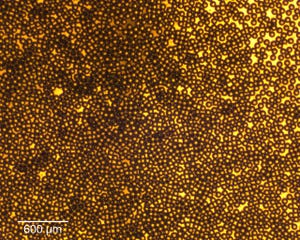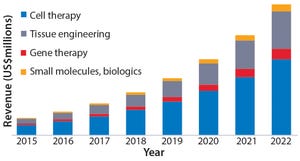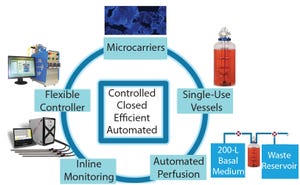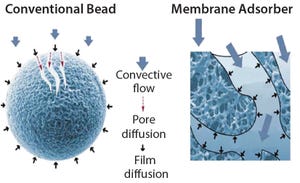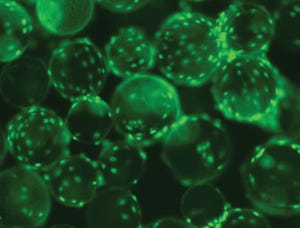February 2017 Featured Report
Accelerating cell growth has become a primary issue, as shown in the cover by Particle Works, which develops alginate and agarose hydrogel beads for three-dimensional cell culture growth. (WWW.PARTICLE-WORKS.COM)
It’s hard to believe that just six years ago,
BioProcess International
published its first cell therapy supplement, which included just one article on “cell therapy bioprocessing” (
1
). At the time, most such processing was conducted in special clinical laboratories and academic institutions. As BPI continued to cover this relatively new segment of the biopharmaceutical industry, we heard more about “the product is the process” and “scale out instead of scaling up.”
After many trials, errors, and milestones, regenerative medicine has become a mainstream part of the biologics industry, supported by at least 670 companies and clinics of all sizes and 20 products approved by the US Food and Drug Administration so far (
2
). As the following article from Swapna Supekar shows, markets for all segme...
Figure 1: World regenerative medicine market by product type, 2015–2022 ($million) (
1
)
One of the fastest growing medical markets with great potential, regenerative medicine treats chronic diseases that were once untreatable. Therapy using live cells is increasingly used to replace damaged tissue, deliver gene therapies to target tissues and organs, and stimulate self-healing along with a number of other applications.
View the full article below – Login Required
Stem cell therapies,
a segment of cell-based therapies, hold huge market potential to revolutionize the treatment modality for regenerating or repairing diseased organs. Advancement in regenerative technologies has fueled the commercial applications of stem cells in the world regenerative medicine market for both allogeneic and autologous therapies.
Gene therapy
involves transplanting genes into a patient’s cells to replace those genes that are leading (or could lead) to particular diseases such as certain cancers or genetic disorders. Such tr...
I first met Chris Mach at the Biotech Week Boston conference in October. We discussed the challenges that biomanufacturers are facing in cell expansion, especially in three specific areas in scale-up systems.
View the full article below – Login Required
Stack Vessels:
Mach said many of his company’s customers are currently facing challenges with selecting the right platforms for growing their cells or viruses. He pointed out that stack vessels perform extremely well in different applications (e.g., for cell therapies), and they’re compact and disposable. “Many customers do not need to invest in large-scale capacities. They can do what they need in a very quick and robust period of time.” Corning provides systems with surface chemistry for adherent cell attachment (e.g., CellSTACK HYPERStack systems). Such chemistries can provide the right environment for cells or viruses to grow and maintain a healthy profile.
Chemically Defined Media:
More than ever, regulators ask biomanufacturers to limit their use o...
Figure 1: Efficiency of Lonza bioreactor platform over traditional 2D planar culture methods
Advances in cell therapy have resulted in significant progress toward treating some widespread and difficult diseases, many of which represent unmet medical needs. For example, phase 3 clinical trials are already under way for therapies based on mesenchymal stem cells (MSCs), including therapies for graft-versus-host disease, acute myocardial ischemia, and chronic obstructive pulmonary disease (COPD) (
1
–
3
).
Successful cell therapy treatments for such afflictions will be not only significant medical breakthroughs, but also in very high demand. However, their commercialization is currently limited by high cost of goods (CoGs) and manufacturers’ inability to scale up manufacturing while maintaining their products’ critical quality attributes. The objective is to develop and integrate manufacturing approaches that will address those gaps.
View the full article below – Login Required
Platform Considerations
The ide...
Figure 1: Viral vector production
Gene therapy is the transfer of genetic material to a patient’s cells to achieve a therapeutic effect. Therapeutic DNA is largely delivered using viral vector systems based on adenoviruses (Ad), adenoassociated viruses (AAV), and lentiviruses (LV). With the application of such viral vectors as clinical therapeutics growing, scalable commercial processes (particularly for purification) are being investigated and optimized to best ensure that critical quality attributes (CQAs) are retained. Herein we review viral vector purification techniques and the effect of different characteristics of vector classes on the selection of optimal unit operations.
View the full article below – Login Required
Table 1: Viral vector overview (
46
–
50
)
Viral Vector Classes
Each class of viral vector has its own challenges and opportunities for gene therapeutics (Table 1). Adenoviruses were initially proposed for gene therapy over 20 years ago, but they are now less popular for clinical appli...
Human mesenchymal stem cells (hMSCs) on Corning Synthemax II polystyrene microcarriers (WWW.CORNING.COM)
Three-dimensional (3D) bioprinting is the newest addition to the regenerative medicine family. Now within the industry dedicated to providing more personalized drug products, this new additive-manufacturing technology has the potential to truly focus on individual tissue repair and replacement. In a short period of time, 3D bioprinting has been applied in studies using bones, blood vessels, composite tissues, vascular grafts, tracheal splints, cartilaginous structures, heart tissue (e.g., two-valve heart), and vaginal organs (
1
).
View the full article below – Login Required
With conference presentations and other studies discussing the future of printable tissues and organs, it’s difficult not to be captivated (
2
). For now, current applications are focused on short-term objectives such as 3D cell cultures, technology advancement, and addressing the critical need for functional living tissues (e.g.,...
